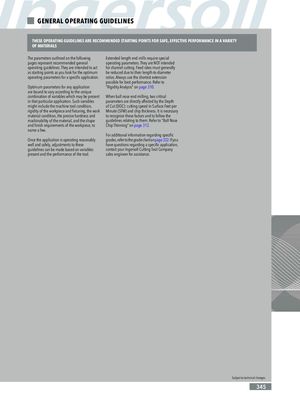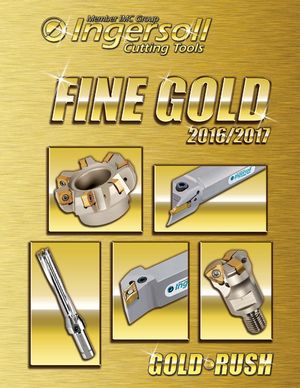Общий каталог Ingersoll 2011 - страница 343
Навигация
- 0003 Table of Contents
- 0006 End Mills
- 0064 Long Edge
- 0104 0Deg Face Mills
- 0160 Face Mills
- 0202 Slotters
- 0218 Form Mills
- 0236 Profile Mills
- 0302 Milling Tech
- 0384 Solid Carbide
- 0448 Solid Carbide Tech
- 0474 Holemaking & Thread Milling
- 0666 Holemaking & Thread Milling Tech
- 0720 Innofit Top On Toolholders
- 0738 HSK Toolholders
- 0774 CAT Toolholders
- 0796 BT Toolholders
- 0816 Adaptions Accessories
- 0872 Turning Inserts
- 1024 Turning Holders
- 1144 Turning Tech
- 1174 Threading Inserts
- 1242 Threading Holders
- 1256 Threading Tech
- 1268 T-Clamp
- 1344 T-Clamp Tech
- 1376 T-CAP
- 1388 T-CAP Tech
- 1394 Product_Index

GENERAL OPERATING GUIDELINES THESE OPERATING GUIDELINES ARE RECOMMENDED STARTING POINTS FOR SAFE, EFFECTIVE PERFORMANCE IN A VARIETY OF MATERIALS The parameters outlined on the following Extended length end mills require special pages represent recommended general operating parameters. They are NOT intended operating guidelines. They are intended to act for channel cutting. Feed rates must generally as starting points as you look for the optimum be reduced due to their length-to-diameter operating parameters for a specific application. ratios. Always use the shortest extension possible for best performance. Refer to Optimum parameters for any application “Rigidity Analysis” on page 310. are bound to vary according to the unique combination of variables which may be present When ball nose end milling, two critical in that particular application. Such variables parameters are directly affected by the Depth might include the machine tool condition, of Cut (DOC): cutting speed in Surface Feet per rigidity of the workpiece and fixturing, the work Minute (SFM) and chip thickness. It is necessary material condition, the precise hardness and to recognize these factors and to follow the machinability of the material, and the shape guidelines relating to them. Refer to “Ball Nose and finish requirements of the workpiece, to Chip Thinning” on page 312. name a few. For additional information regarding specific Once the application is operating reasonably grades,refertothegradechartonpage322.If you well and safely, adjustments to these have questions regarding a specific application, guidelines can be made based on variables contact your Ingersoll Cutting Tool Company present and the performance of the tool. sales engineer for assistance. Subject to technical changes. 345
 Общий каталог Ingersoll 2016 - 2017
Общий каталог Ingersoll 2016 - 2017 Общий каталог Ingersoll 2014
Общий каталог Ingersoll 2014 Каталог Ingersoll инструмент для нарезания резьбы
Каталог Ingersoll инструмент для нарезания резьбы Общий каталог Ingersoll 2013 - 2014
Общий каталог Ingersoll 2013 - 2014 Каталог Ingersoll новинки 2021
Каталог Ingersoll новинки 2021